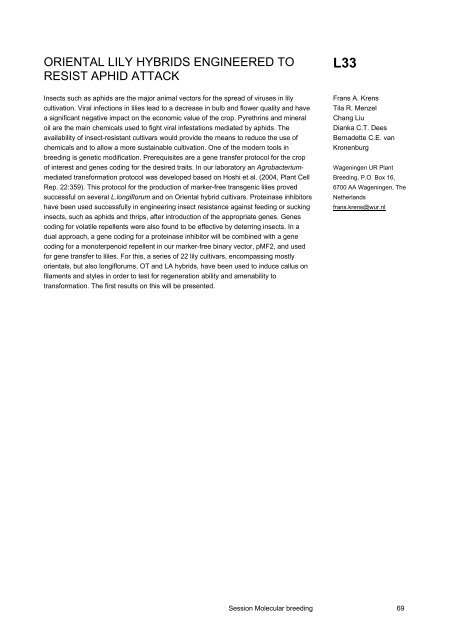XXIIIrd International Eucarpia symposium, Section Ornamentals ...
XXIIIrd International Eucarpia symposium, Section Ornamentals ...
XXIIIrd International Eucarpia symposium, Section Ornamentals ...
Create successful ePaper yourself
Turn your PDF publications into a flip-book with our unique Google optimized e-Paper software.
ORIENTAL LILY HYBRIDS ENGINEERED TO<br />
RESIST APHID ATTACK<br />
Insects such as aphids are the major animal vectors for the spread of viruses in lily<br />
cultivation. Viral infections in lilies lead to a decrease in bulb and flower quality and have<br />
a significant negative impact on the economic value of the crop. Pyrethrins and mineral<br />
oil are the main chemicals used to fight viral infestations mediated by aphids. The<br />
availability of insect-resistant cultivars would provide the means to reduce the use of<br />
chemicals and to allow a more sustainable cultivation. One of the modern tools in<br />
breeding is genetic modification. Prerequisites are a gene transfer protocol for the crop<br />
of interest and genes coding for the desired traits. In our laboratory an Agrobacteriummediated<br />
transformation protocol was developed based on Hoshi et al. (2004, Plant Cell<br />
Rep. 22:359). This protocol for the production of marker-free transgenic lilies proved<br />
successful on several L.longiflorum and on Oriental hybrid cultivars. Proteinase inhibitors<br />
have been used successfully in engineering insect resistance against feeding or sucking<br />
insects, such as aphids and thrips, after introduction of the appropriate genes. Genes<br />
coding for volatile repellents were also found to be effective by deterring insects. In a<br />
dual approach, a gene coding for a proteinase inhibitor will be combined with a gene<br />
coding for a monoterpenoid repellent in our marker-free binary vector, pMF2, and used<br />
for gene transfer to lilies. For this, a series of 22 lily cultivars, encompassing mostly<br />
orientals, but also longiflorums, OT and LA hybrids, have been used to induce callus on<br />
filaments and styles in order to test for regeneration ability and amenability to<br />
transformation. The first results on this will be presented.<br />
L33<br />
Frans A. Krens<br />
Tila R. Menzel<br />
Chang Liu<br />
Dianka C.T. Dees<br />
Bernadette C.E. van<br />
Kronenburg<br />
Wageningen UR Plant<br />
Breeding, P.O. Box 16,<br />
6700 AA Wageningen, The<br />
Netherlands<br />
frans.krens@wur.nl<br />
Session Molecular breeding 69














